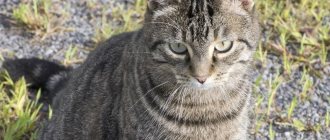Home » Breeds » About the Brazilian Shorthair cat breed
In Brazil there are large cats - puma and jaguar, weighing up to 100 kg. and up to 2 meters long.
There are smaller cats - the ocelot and as many as 2 types of wild forest cats: straw and forest tiger. Actually, the ocelot is also a wild Brazilian cat, known since 1758. It is famous for the fact that at one time it was barbarically exterminated because of its unique skin. Now, thank God, hunting him is prohibited. Only poachers remain, but now the hunt is for them, and not for the Jaguatirica - that’s what the Brazilians call their spotted wild cat, which climbs branches no worse, and in some cases even better than a monkey.
But now we will not talk about all cats in Brazil, but only about the breed, which is called the Brazilian Shorthair cat.
History of the breed
South America has long been an isolated continent. Before the active development of trade between countries and the establishment of transport links, it was quite isolated from European countries. During the heyday of trade, sailors transported not only food and textiles on their ships. Each ship had furry pets that helped people fight rodents. This is how the first smooth-haired cats came to hot Brazil. Under the influence of climate and a number of other reasons, natural mutations inevitably occurred, which allowed the formation of certain characteristics of these animals, as a result of which a separate breed was identified.
In the eighties of the last century, a general population census took place in Brazil, during which specialists paid close attention to the typical folk cats of this country.
Employees of the Brazilian Federation of Cat Fanciers BCF under the leadership of Paulo Samuel Ruscha. conducted a study of all populations of yard cats and found that these animals are significantly different from the breeds known in the world.
In 1985, the national cat breed program was launched. Felinologists in Europe and North America categorically did not recognize the Brazilian cat as a separate cat species. But the history of the American and European Shorthairs was absolutely similar; they, too, were not always purebred. Perhaps all these companion animals have common wild roots, but on each continent the species, due to natural reasons, mutates and acquires characteristics characteristic of the given area.
To simplify the task, Brazilian felinologists united their animals with the European Shorthair under the single name Celtic cat. Already in 1996, the Brazilian breed was pre-registered in the American association FIFe, and in 1999 the European WCF system identified the Brazilian Shorthair as an independent breed.
Natural origin can hardly reduce the importance of a Brazilian for his country and the whole world. These animals defended their right to the title of breed. They have a unique gene pool, good health and character, which the indigenous people of the continent have the right to be proud of.
“People who see faces do not see hearts” - this is what the people of Brazil say. They considered the unique qualities of their national cat and were able to convince the whole world of its exclusivity.
Where to buy a kitten. Price
The breed is recognized and distributed only in Brazil. It is almost impossible to meet such cats outside the country.
Since the breed is not yet independent, and it is not known how soon this will happen, people abroad are not too interested in purchasing. And the Brazilian breeders themselves are in no hurry to sell off valuable breeding material. If you come across an advertisement on the Internet for the sale of a Brazilian Shorthair, then most likely this is a marketing ploy, and behind the beautiful name lies an ordinary yard cat. In their homeland, kittens cost an average of $500.
Mister Cat Recommends: Personality of the Brazilian Cat
This is definitely a companion animal. Loyal character, high intelligence, good learning ability and flexibility of behavior, the ability to correct temperament at any age - these are the distinctive character traits of the Brazilian cat.
This pet may need quite some time to get acquainted with its new home and its inhabitants, but after it gets used to it, it becomes a truly full-fledged owner and protector. He always runs to meet any guest, sees, hears and controls everything.
The Brazilian is stress-resistant and easily adapts to new circumstances and situations. The temperament of these animals has been formed over centuries, and they definitely know how to survive in any conditions.
Friendly to everyone. They get along easily with any pets.
They are very patient with children and easily tolerate even annoying treatment. They will never hurt a child.
Basic moments
- This breed has been around the British for so long that in its homeland it is simply called shorthair.
- Recognizable features are a round muzzle, a stocky body and thick fur of a special texture, tactilely reminiscent of plush.
- Long before the appearance of the first “cat” organizations, the British Shorthair cat was valued not for its external qualities, but for its unsurpassed skill as a mouser.
- Animals openly show their affection for their owners, but do not like to sit on a person’s lap or hang in a person’s arms.
- They get along well with other pets (including dogs, rodents and birds), but do well as an only pet.
- Cats do not require complex and specific care.
- After reaching adulthood, the level of physical activity decreases significantly.
- Veterinarians call obesity the main danger facing British apartment dwellers.
- British Shorthairs are generally considered to be healthy cats, with an average lifespan of 12-17 years.
The British Shorthair cat is one of the breeds that nature has worked on much longer than humans. As a result, we have a physically developed, harmoniously built animal with a light, easy-going character. Living together with him will not cause the owners much trouble. British cats are attractive due to their calm disposition, bordering on phlegmaticity, good manners and incredibly beautiful, pleasant to the touch plush fur. In the famous book “Alice in Wonderland” Lewis Carroll forever immortalized this breed in the image of the Cheshire cat.
Care, nutrition and maintenance
These animals are completely unpretentious to care for.
Their short coat, without undercoat, is still susceptible to heavy shedding, especially with coarse coats. Natural hair change occurs quite seasonally. During this period, pets need daily brushing. At other times, you can use a medium-hard brush to walk over the animal’s coat once a week solely for massage.
They do not like washing and, unless there is an urgent need for it, it is better to do without frequent bathing.
Care for the eyes, ears, mouth and nails should be regular, at least weekly.
The Brazilian is very smart and easy to train. It is necessary to accustom him to a litter tray and scratching post from an early age, and then there will be no problems in maintaining and caring for him.
Appearance
Brazilian Shorthair cats are strong, robust, well-proportioned, medium-sized animals. Their chest is strong, wide and round. The legs are strong, the tail is quite long and thick at the base. The head is slightly elongated in length. Chin with a slight curve at the base. The nose is the same width along its entire length. The ears are medium-sized, with round tips. The eyes are round, wide open, moderately spaced from each other. The color of the iris is yellow or green; in white cats it can be blue. The coat is short, silky and thick, lying close to the skin. Colors can be very diverse; only color point, chocolate, blue and their shades are not allowed.
Health and nutrition
Like any natural breed, they have good health and do not suffer from any hereditary diseases. They are also unpretentious in food. But you shouldn’t feed from the master’s table.
It is better to choose good ready-made dry mixes - premium or super-premium. In the case of natural nutrition (poultry, beef, dairy products), it is necessary to include in the diet vitamins and additional food additives containing the missing micro and macroelements.
Price
Despite the popularity of cats in their homeland, the Brazilian Shorthair cat is not often found in Russia, so this fact is reflected in the cost. In addition, the breeder includes the costs of maintaining breeding animals and offspring into the total cost. In addition to food, the breeder spends money on veterinarian services, preparation of necessary documents for offspring, and animal care, which is reflected in the final price. A Brazilian Shorthair kitten costs over 75,000 rubles.
Similar articles:
- Ural rex
- Cornish Rex
- European shorthair cat
- Arabian Mau
- Burmese cat
- Chantilly Tiffany
Description
The appearance of the animals is not outstanding, but quite cute.
- The body is of medium length with a wide chest and well-developed muscles.
- The limbs are strong, of standard size, with rounded pads on the paws.
- The head is slightly elongated and wedge-shaped. The muzzle has pleasant contours.
- Standard wide-set triangular ears, rounded at the ends.
- Beautiful almond-shaped eyes with a smart, piercing gaze, the color of which can be absolutely any.
- The coat is without undercoat, short, close to the body, silky to the touch. The variety of colors is unlimited.
- The tail is wide at the base and tapered at the tip.
- Strong strong neck of normal length.
According to standards, weight is allowed up to 4 kg, the cat looks noticeably larger than the cat.
Photos
Photos of Brazilian Shorthair cats:
Sometimes nature itself comes to the rescue of selection and gives unusual surprises. The Brazilian Shorthair cat is just such a gift . These four-legged friends have been accompanying people for many years and during this time they have managed to prove their love and devotion. Despite the most ordinary, one might say unremarkable appearance, the breed is winning an increasing number of fans every year.











